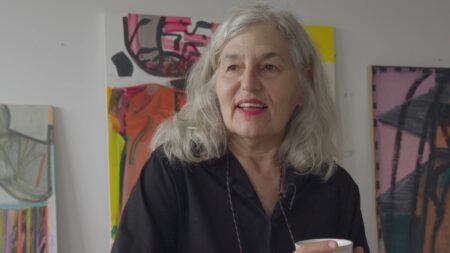Continue playing
(Time remaining: )
Play from beginning
Continue playing "{{ controller.videos[controller.getVideo(controller.currentVideo)].segmentParentTitle}}"
{{controller.videos[controller.getVideo(controller.currentVideo)].title}} has ended.
Painting from LifeAliza Nisenbaum
In the close quarters of a New York City apartment, two friends cook a meal together and talk about the beginnings of their decade-long friendship. Artist Aliza Nisenbaum began her friendship with Veronica Ramírez and her observational portrait painting practice in 2012 at artist Tania Bruguera’s Immigrant Movement International (IMI) in Corona, Queens. The two met in an English language course that Nisenbaum taught through feminist art history, and when the artist asked to paint portraits of her students, Ramírez was one of the first. Since then, Nisenbaum has continued to paint vibrant and detailed portraits from life, including numerous paintings of Ramírez and her extended family. In her studio at the Queens Museum, the artist sits and talks with Ramírez’s daughter, Marissa Campiz, as she puts the finishing touches on her latest painting of the mother and daughter.
Before painting portraits, Nisenbaum had moved from her hometown of Mexico City to the United States, where she studied at the School of the Art Institute of Chicago and worked in abstract painting. Later, the artist moved to New York City and began a series of still lifes of flowers inspired by the floral arrangements of Mexican street vendors. Still, it was not until her time at IMI that she began her present-day practice in observational portraiture. Ten years after she began teaching at IMI, Nisenbaum’s socially engaged practice returns to Queens as part of a two-year residency at the Queens Museum, where she teaches art-making courses to the La Jornada and Queens Museum Cultural Food Pantry volunteers. Much like at IMI, Nisenbaum’s course provides valuable skills, avenues for expression, and access to community for her students. At the culmination of her residency, Nisenbaum mounts her solo exhibition Queens, Lindo y Querido, where her portraits of the Corona community, including Ramírez and Campiz, volunteers at the food pantry, and more, are exhibited alongside the works of Nisenbaum’s students at the Queens Museum. Through her practice, the artist celebrates human connection and understanding, spotlighting individuals who facilitate community. “The biggest resource we have are these relationships.” says Nisenbaum, “Your resources are the people around you.”
More information and creditsCredits
Extended Play Series Producer: Ian Forster. Director: Ian Forster. Editor: Andrea Cruz. Camera: Sebastián Lasaosa Rogers. Additional Camera: Michelle Hanks, Miasarah Lai, Rafael Salazar Moreno. Sound: Ana Fernández, Ava Wiland. Colorist: Russell Yaffe. Sound Mix: Collin Blendell. Associate Producer: Andrea Chung. Associate Curator: Jurrell Lewis. Assistant Editor: Michelle Hanks. Music: Blue Dot Sessions, Epidemic Sound.
Artwork Courtesy: Aliza Nisenbaum, Anton Kern Gallery. Very Special Thanks: Marissa Campiz, Veronica Ramírez. Special Thanks: Tania Bruguera, Immigrant Movement International, Mobile Print Power, Mujeres en Movimiento, The People’s Bus, Queens Museum. Workshop Participants: Luz Caicedo, Marleny Castro, Emma Confesor, Diane Crystal Confesor, Gianina Enriquez,
Miguel Flores, Karina Mendieta, Ximena Morales, Maria Morales, Abril Rodríguez, Eloina Rodríguez, Samir Urdinola, Maria Fernanda Zambrano.
Extended Play is presented by the Marina Kellen French Foundation, with support from The Andy Warhol Foundation for the Visual Arts, public funds from the New York City Department of Cultural Affairs in partnership with the City Council, the New York State Council on the Arts with the support of the Office of the Governor and the New York State Legislature, the Art21 Contemporary Council, and individual contributors. Producers: Barbara & Andrew Gundlach.
Closed captionsAvailable in English, German, Romanian, Italian, Japanese, Korean, Chinese, Italian
Through the Art21 Translation Project, multilingual audiences from around the globe can contribute translations, making Art21 films more accessible worldwide. Translate this video now.
Interested in showing this film in an exhibition or public screening? To license this video please visit Licensing & Reproduction.
Aliza Nisenbaum was born in 1977 in Mexico City, Mexico, and lives and works in Queens, New York. In 2001 Nisebaum received her BFA from the School of the Art Institute of Chicago, later receiving her MFA from the same institution in 2005. Painting portraits of individuals and groups, the artist forms intimate relationships with her sitters that become evident in highly detailed paintings that humanize, honor, and make visible the underrepresented and underserved. Her portraits often depict her subjects in moments of reprieve or contemplation, revealing an interiority to the figure while situating them in environments that reflect their cultures, personalities, and relationships. Throughout her practice, Nisenbaum demonstrates the value of caring, compassionate, and ethical relationships and makes politically potent work through who and how she chooses to represent.
“The biggest resource we have is these relationships and the communities that have continued. Your resources are your people around you.”
Aliza Nisenbaum

